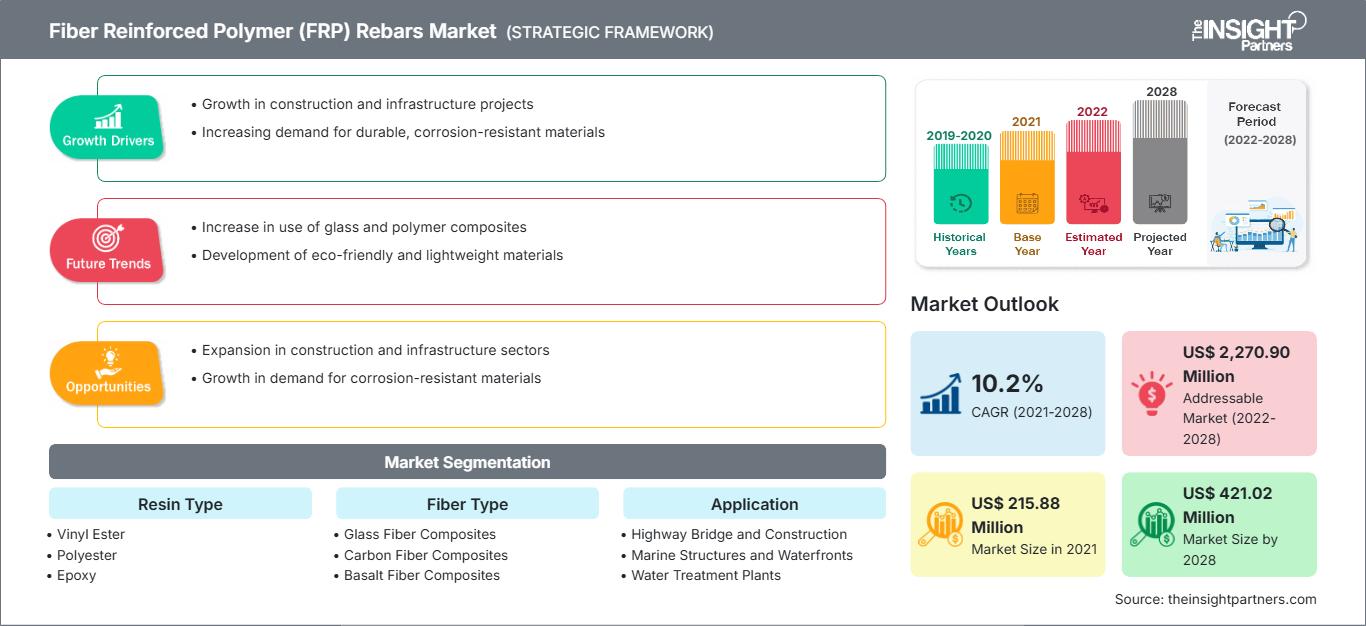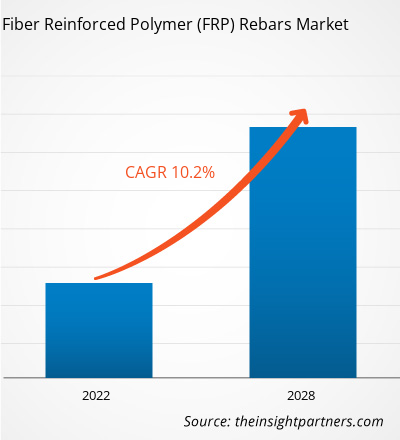繊維強化ポリマー(FRP)鉄筋市場は、2021年の2億1,588万米ドルから2028年には4億2,102万米ドルに成長すると予想されており、2022年から2028年にかけて年平均成長率(CAGR)10.2%で成長すると推定されています。
コンクリートは圧縮に強く、引張に弱いため、通常は強化されて引張と圧縮に強い建築材料になります。この補強材には、低コスト、高強度、高弾性の鋼が従来使用されています。しかし、鋼の腐食により、政府や資産所有者は老朽化したインフラを交換または修理するためのメンテナンス費用として数十億ドルを負担する可能性があります。腐食を防ぐために使用できるコンクリート補強材の代替品はほとんどありません。たとえば、一部のメーカーはステンレス鋼の鉄筋を提供していますが、繊維強化ポリマー鉄筋は、コンクリート補強用の従来の鋼鉄鉄筋の非腐食性の代替品として機能します。これらのFRP鉄筋は、ポリマーマトリックスとガラス繊維、炭素繊維、または玄武岩繊維を組み合わせて作られています。これらの材料は錆びず、鋼鉄よりもはるかに軽量で、熱を伝導せず、引張強度はほぼ4倍です。この耐腐食性により、繊維強化ポリマーは擁壁、桟橋、突堤、岸壁、ケーソン、デッキ、隔壁、杭、運河、洋上プラットフォーム、プール、水槽など、様々な建設用途に最適な代替材料となります。
さらに、電磁波に敏感な用途においても、FRP鉄筋のガラスとポリマーの非導電性は電流を伝導せず、落雷を誘引せず、近くの電気機器の動作を妨害することもありません。そのため、アルミニウムや銅の精錬工場、空港の塔、原子力発電所、特殊な軍事施設、電力や電話の送信塔、電気機器や電話機器が入っているマンホール、磁気共鳴画像診断装置 (MRI) を備えた病院などでは、繊維強化ポリマーが鉄鋼よりも安全な代替品となります。
要件に合わせてレポートをカスタマイズ
レポートの一部、国レベルの分析、Excelデータパックなどを含め、スタートアップ&大学向けに特別オファーや割引もご利用いただけます(無償)
繊維強化ポリマー(FRP)鉄筋市場: 戦略的洞察

- このレポートの主要な市場動向を入手してください。この無料サンプルには、市場動向から見積もりや予測に至るまでのデータ分析が含まれます。
レポートの一部、国レベルの分析、Excelデータパックなどを含め、スタートアップ&大学向けに特別オファーや割引もご利用いただけます(無償)
繊維強化ポリマー(FRP)鉄筋市場: 戦略的洞察

- このレポートの主要な市場動向を入手してください。この無料サンプルには、市場動向から見積もりや予測に至るまでのデータ分析が含まれます。
市場洞察
建設活動の増加が繊維強化ポリマー(FRP)鉄筋市場の成長を後押し
建設業界は、世界中の経済発展に大きく貢献している。世界中のインフラ開発に対する政府の支援の増加により、建設業界は急速に繁栄している。例えば、インドは2019年から2023年にかけて国家インフラパイプラインを通じてインフラに1.4兆米ドルを費やす計画だった。このパイプラインには、電力、橋梁、ダム、道路、都市インフラ開発などのインフラが含まれている。繊維強化ポリマーは、高強度、耐霜性および耐氷塩性、交通への影響が最小限で設置時間が短いなどの有利な材料特性により、橋梁構造物の貴重な代替建築材料として成熟している。各国政府のこのような取り組みは、繊維強化ポリマー(FRP)鉄筋市場の成長を後押しすると期待されています。
樹脂タイプの洞察
樹脂タイプに基づいて、世界の繊維強化ポリマー(FRP)鉄筋市場は、ビニルエステル、ポリエステル、エポキシ、その他に分類されています。 2021年には、ビニルエステルセグメントが最大の市場シェアを占めました。ビニルエステル樹脂は、強度が高く、腐食、燃料、化学薬品、または蒸気に対して高い耐性があり、機械的靭性を提供します。耐久性、耐熱性、および高い引張伸び強度を備えています。この樹脂に短ガラス繊維または炭素繊維を含浸させてFRP鉄筋を製造できます。繊維強化ポリマー鉄筋メーカーの大半は、ビニルエステル樹脂を使用しています。ビニルエステルの費用対効果により、このセグメントの成長が促進されました。
Owens Corning; KODIAC Fiberglass Rebar; MARSHALL COMPOSITE TECHNOLOGIES, LLC、TUF-BAR、Armastek USA、Pultron Composites、FiRep Inc.、PULTRALL, Inc.、Schock Bauteile GmbH、Dextra Groupは、世界的な繊維強化ポリマー(FRP)鉄筋市場で事業を展開する主要企業です。主要企業は、合併・買収や新製品の発売といった戦略を採用することで、地理的プレゼンスと顧客基盤を拡大しています。例えば、Pultron Compositesは、サウジアラビアの大手石油会社であるサウジアラムコと提携し、同国におけるガラス繊維強化ポリマー(GFRP)鉄筋生産施設の増強を図りました。
繊維強化ポリマー(FRP)鉄筋市場の地域別分析
The Insight Partnersのアナリストは、予測期間全体を通して繊維強化ポリマー(FRP)鉄筋市場に影響を与える地域的な動向と要因を詳細に解説しています。このセクションでは、北米、ヨーロッパ、アジア太平洋、中東・アフリカ、中南米における繊維強化ポリマー(FRP)鉄筋市場のセグメントと地域についても解説します。
繊維強化ポリマー(FRP)鉄筋市場レポートの範囲
| レポート属性 | 詳細 |
|---|---|
| の市場規模 2021 | US$ 215.88 Million |
| 市場規模別 2028 | US$ 421.02 Million |
| 世界的なCAGR (2021 - 2028) | 10.2% |
| 過去データ | 2019-2020 |
| 予測期間 | 2022-2028 |
| 対象セグメント |
By 樹脂の種類
|
| 対象地域と国 | 北米
|
| 市場リーダーと主要企業の概要 |
|
繊維強化ポリマー(FRP)鉄筋市場のプレーヤーの密度:ビジネスダイナミクスへの影響を理解する
繊維強化ポリマー(FRP)鉄筋市場は、消費者の嗜好の変化、技術の進歩、製品の利点に対する認知度の高まりといった要因によるエンドユーザーの需要増加に牽引され、急速に成長しています。需要の増加に伴い、企業は製品ラインナップの拡充、消費者ニーズへの対応のための革新、そして新たなトレンドの活用を進めており、これが市場の成長をさらに加速させています。

- 入手 繊維強化ポリマー(FRP)鉄筋市場 主要プレーヤーの概要
レポートの注目点
- 繊維強化ポリマー(FRP)鉄筋業界の進歩的な傾向。企業が効果的な長期戦略を策定するのに役立ちます
- 先進国市場と発展途上国市場での成長を確保するために企業が採用しているビジネス成長戦略
- 2022年から2028年までの世界の繊維強化ポリマー(FRP)鉄筋市場の定量分析
- 繊維強化ポリマー(FRP)鉄筋の需要の推定
- 市場で事業を展開しているバイヤーとサプライヤーの有効性を示すポーター分析。市場の成長を予測するために
- 競争の激しい市場の状況と繊維強化ポリマー(FRP)鉄筋の需要を理解するための最近の動向
- 市場の動向と展望、および世界の繊維強化ポリマー(FRP)鉄筋市場の成長を促進および抑制する要因
- 商業的関心を支える戦略を理解する世界の繊維強化ポリマー(FRP)鉄筋市場の成長に関する分析を提供し、意思決定プロセスを支援します。
- 市場のさまざまなノードにおける世界の繊維強化ポリマー(FRP)鉄筋市場規模
- 世界の繊維強化ポリマー(FRP)鉄筋市場の詳細な概要とセグメンテーション、およびその業界ダイナミクス
- 有望な成長機会のあるさまざまな地域における世界の繊維強化ポリマー(FRP)鉄筋市場規模
「2028年までの繊維強化ポリマー(FRP)鉄筋市場分析」は、繊維強化ポリマー(FRP)鉄筋市場の動向分析に焦点を当てた、化学および材料業界の専門的かつ詳細な調査です。このレポートは、詳細なセグメンテーションとともに市場の概要を提供することを目的としています。繊維強化ポリマー(FRP)鉄筋市場は、樹脂の種類、繊維の種類、用途、および地域に分類されています。樹脂の種類に基づいて、市場はビニルエステル、ポリエステル、エポキシなどに分割されています。繊維の種類に基づいて、市場はガラス繊維複合材、炭素繊維複合材、玄武岩繊維複合材に分類されます。用途に基づいて、市場は高速道路橋梁・建設、海洋構造物・ウォーターフロント、水処理プラント、その他に分類されます。地域に基づいて、市場は北米、ヨーロッパ、アジア太平洋、中東・アフリカ、南米・中米の5つの主要地域に分類されます。2021年には、繊維強化ポリマー(FRP)鉄筋市場は北米が市場を支配しました。しかし、予測期間中、アジア太平洋地域は市場で最も高いCAGRを記録すると予想されています。
- 過去2年間の分析、基準年、CAGRによる予測(7年間)
- PEST分析とSWOT分析
- 市場規模価値/数量 - 世界、地域、国
- 業界と競争環境
- Excel データセット
最新レポート
お客様の声
購入理由
- 情報に基づいた意思決定
- 市場動向の理解
- 競合分析
- 顧客インサイト
- 市場予測
- リスク軽減
- 戦略計画
- 投資の正当性
- 新興市場の特定
- マーケティング戦略の強化
- 業務効率の向上
- 規制動向への対応




















 無料サンプルを入手 - 繊維強化ポリマー(FRP)鉄筋市場
無料サンプルを入手 - 繊維強化ポリマー(FRP)鉄筋市場